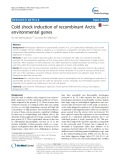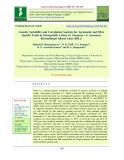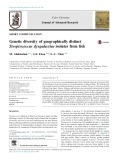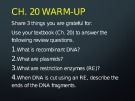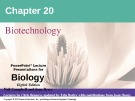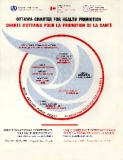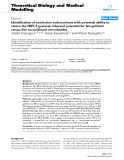
Restricted recombination
-
The black yeast Hortaea werneckii (Dothideomycetes, Ascomycota) is one of the most extremely halotolerant fungi, capable of growth at NaCl concentrations close to saturation. Although dothideomycetous fungi are typically haploid, the reference H. werneckii strain has a diploid genome consisting of two subgenomes with a high level of heterozygosity.
 12p
12p  vibeauty
vibeauty
 23-10-2021
23-10-2021
 12
12
 1
1
 Download
Download
-
Chapter 20 - DNA technology and genomics. This chapter presents the following content: DNA technology makes it possible to clone genes for basic research and commercial applications, restriction enzymes are used to make recombinant DNA, genes can be clones in recombinant DNA vectors,...
 113p
113p  tradaviahe19
tradaviahe19
 29-03-2021
29-03-2021
 9
9
 1
1
 Download
Download
-
Heterologous expression of psychrophilic enzymes in E. coli is particularly challenging due to their intrinsic instability. The low stability is regarded as a consequence of adaptation that allow them to function at low temperatures.
 12p
12p  viuchiha2711
viuchiha2711
 21-04-2020
21-04-2020
 15
15
 1
1
 Download
Download
-
The methanol-regulated AOX1 promoter (PAOX1) is the most widely used promoter in the production of recombinant proteins in the methylotrophic yeast Pichia pastoris. However, as the tight regulation and methanol dependence of PAOX1 restricts its application, it is necessary to develop a flexible induction system to avoid the problems of methanol without losing the advantages of PAOX1.
 10p
10p  vihamax2711
vihamax2711
 21-04-2020
21-04-2020
 14
14
 1
1
 Download
Download
-
Bougainvillea antiviral protein (BAP) is one among a class of the ribosomal inactivating proteins isolated from Bougainvillea spectabilis willd. Truncated version of the BAP gene was cloned and expressed in a prokaryotic vector to abolish its cytotoxicity. RNA was isolated from mature leaves of Bougainvillea and the full length cDNA was amplified by reverse transcription-PCR using template mRNA. This full length cDNA of size 756 bp was amplified using the proofreading polymerase (Q5 polymerase) and end to end gene specific primers for removal of C-terminal, the amplicon was cloned in pJET1.
 9p
9p  chauchaungayxua3
chauchaungayxua3
 07-02-2020
07-02-2020
 15
15
 2
2
 Download
Download
-
Cotton, Recombinant inbred lines (RIL), phenotypic (PCV) and There is a limited genetic variability available in genetic resources of upland cotton (Gossypium hirsutum L.), which restricted the breeding activity. The objective of present study was evaluating the genetic variability in RIL population derived through intraspecific hybridization between RHAP 12 and RHAP 15 genotypes. The 222 RIL were evaluated during kharif 2018 at University of Agricultural Sciences Dharwad.
 11p
11p  nguaconbaynhay3
nguaconbaynhay3
 07-02-2020
07-02-2020
 20
20
 0
0
 Download
Download
-
Streptococcus dysgalactiae is an emerging pathogen of fish. Clinically, infection is characterized by the development of necrotic lesions at the caudal peduncle of infected fishes. The pathogen has been recently isolated from different fish species in many countries. Twenty S. dysgalactiae isolates collected from Japan, Taiwan, Malaysia and Indonesia were molecularly characterized by biased sinusoidal field gel electrophoresis (BSFGE) using SmaI enzyme, and tuf gene sequencing analysis. DNA sequencing of ten S.
 6p
6p  trinhthamhodang1
trinhthamhodang1
 16-11-2019
16-11-2019
 14
14
 0
0
 Download
Download
-
Chapter 12 - DNA technology and genomics. The main contents of this chapter include all of the following: DNA technology makes it possible to clone genes for basic research and commercial applications, restriction enzymes are used to make recombinant DNA, genes can be clones in recombinant DNA vectors.
 89p
89p  shiwo_ding2
shiwo_ding2
 03-04-2019
03-04-2019
 20
20
 1
1
 Download
Download
-
After completing this chapter, students will be able to: Describe the natural function of restriction enzymes and explain how they are used in recombinant DNA technology; outline the procedures for cloning a eukaryotic gene in a bacterial plasmid; define and distinguish between genomic libraries using plasmids, phages, and cDNA;...
 42p
42p  nomoney10
nomoney10
 04-05-2017
04-05-2017
 28
28
 3
3
 Download
Download
-
Chapter 20 introduce to biotechnology. After completing this chapter, students will be able to: Describe the natural function of restriction enzymes and explain how they are used in recombinant DNA technology; outline the procedures for cloning a eukaryotic gene in a bacterial plasmid; define and distinguish between genomic libraries using plasmids, phages, and cDNA; describe the polymerase chain reaction (PCR) and explain the advantages and limitations of this procedure;...
 61p
61p  tangtuy02
tangtuy02
 08-03-2016
08-03-2016
 37
37
 2
2
 Download
Download
-
After studying chapter 23 you will be able to: Know the general properties of a plasmid, know the general properties of restriction endonucleases, know the general properties of restriction endonucleases, know why we transform plasmids into bacteria, know how a cDNA Library is constructed, know how to make cDNA, know why we need to make cDNA,....
 17p
17p  tangtuy02
tangtuy02
 08-03-2016
08-03-2016
 35
35
 2
2
 Download
Download
-
Yet, not enough countries use these and other effective policy options to prevent death, disease and injury attributable to alcohol consumption. Since 1999, when WHO fi rst began to report on alcohol policies, at least 34 countries have adopted some type of formal policies. Restrictions on alcohol marketing and on drink–driving have increased but, in general, there are no clear trends on most preventive measures.
 5p
5p  quygia123
quygia123
 01-11-2012
01-11-2012
 59
59
 1
1
 Download
Download
-
Tuyển tập các báo cáo nghiên cứu về y học được đăng trên tạp chí y học quốc tế cung cấp cho các bạn kiến thức về ngành y đề tài: " Identification of restriction endonuclease with potential ability to cleave the HSV-2 genome: inherent potential for biosynthetic versus live recombinant microbicides
 12p
12p  toshiba17
toshiba17
 28-10-2011
28-10-2011
 54
54
 2
2
 Download
Download
CHỦ ĐỀ BẠN MUỐN TÌM










